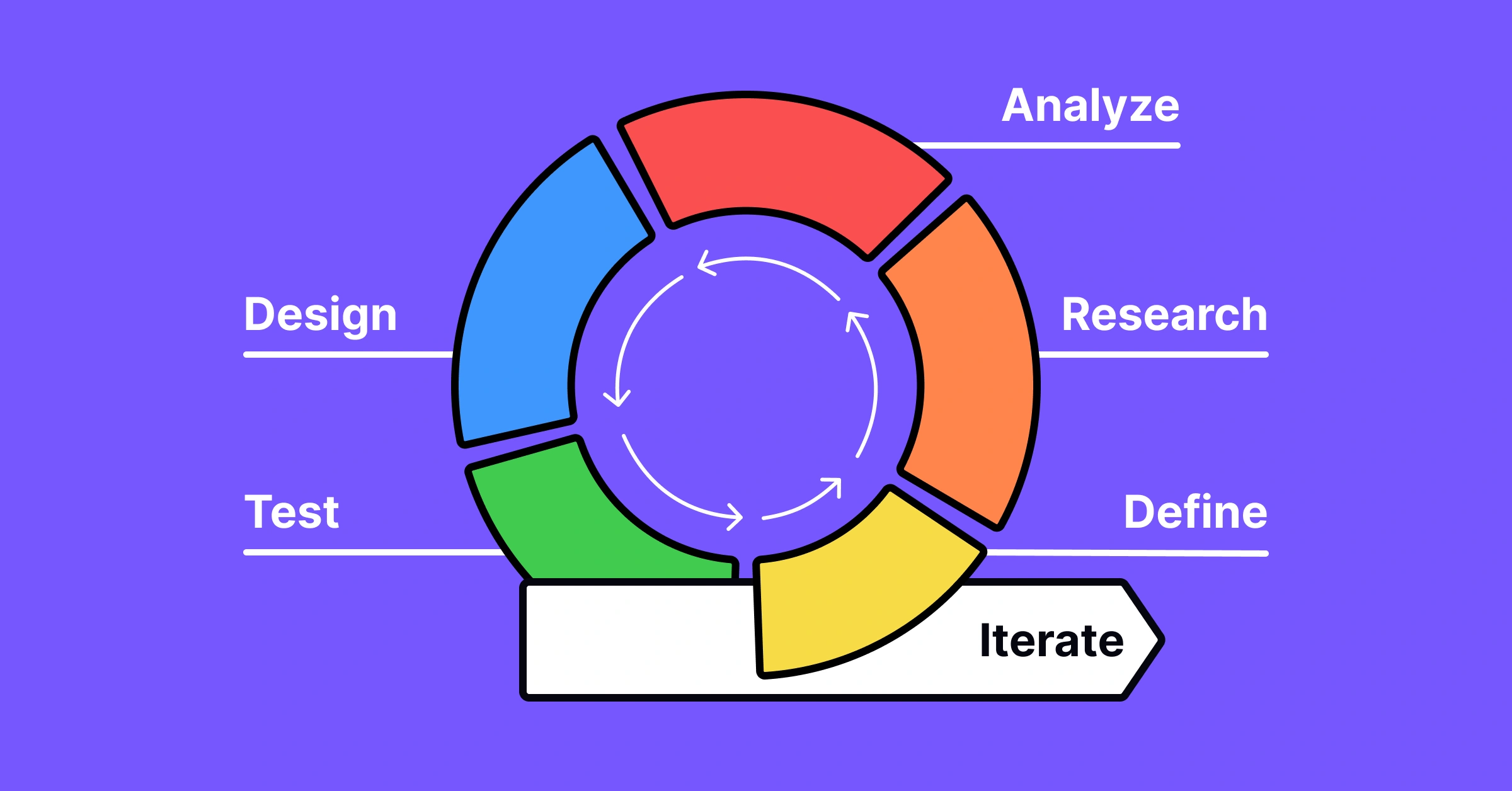Mastering the UX Design Process
 Theophilus Uwoghiren
Theophilus Uwoghiren
User Experience (UX) design is more than just creating a visually appealing interface; it's about crafting an interaction that resonates with users, addresses their needs, and leaves them with a positive impression. To achieve this, designers follow a well-structured process that guides them from the initial idea to the final product. In this article, we will delve into the stages of the UX design process and explore how each contributes to creating exceptional user experiences.
What is a UX Design Process?
A UX design process is a systematic approach that designers employ to transform an idea into a user-friendly interface. While the specifics may vary from project to project, a typical UX design process consists of the following stages:
1. Define:
The Define stage in the UX design process serves as the foundation upon which the entire project is built. Here, the primary objectives are to establish a clear understanding of the project's purpose and to define its objectives. Key aspects of this stage include:
Project Purpose: Designers need to answer the fundamental question of why the product is necessary. This involves identifying the problem or need that the product aims to address. For instance, if the project is to create a new mobile app, understanding the problem it will solve or the value it will add is crucial.
Intended Users: Knowing who the product is intended for is essential. Designers must define the target audience and gather insights into their preferences, behaviors, and expectations. This helps in tailoring the user experience to meet the specific needs of this group.
Stakeholder Meetings: Collaborative discussions with stakeholders, such as clients, project managers, and subject matter experts, are integral to this stage. These meetings help align the project's goals with the business strategy and ensure that everyone involved has a shared vision.
Concept Sketches: At this early stage, concept sketches may be created to visualize initial ideas. These sketches are typically low-fidelity representations that provide a rough outline of the product's structure and features. While not detailed designs, they help in visualizing the direction the project is taking.
In summary, the Define stage lays the groundwork for the UX design process by clarifying the project's purpose, target audience, and initial ideas. It sets the stage for subsequent research and design activities.
2. Research:
The Research stage is a critical component of the UX design process, focusing on gathering information that will inform the design decisions. Here's a more detailed look at this stage:
User Research: Designers conduct user research to gain deep insights into the intended users. This may involve activities like interviews, surveys, and observations. The goal is to understand users' behaviors, pain points, needs, and preferences. For instance, if designing an e-commerce website, user research might reveal that users prefer a streamlined checkout process.
Market Research: In addition to understanding users, designers also examine the broader market landscape. This includes studying competitors, industry trends, and emerging technologies. Market research helps identify opportunities for differentiation and ensures that the product aligns with market demands.
Data Gathering: Usability data and analytics from existing products or similar projects can be valuable sources of information. They provide insights into how users currently interact with digital interfaces and highlight areas for improvement.
Personas: Based on the user research findings, designers create user personas. These are fictional characters representing different user types, complete with demographic details, goals, and pain points. Personas humanize the user base and guide design decisions.
Empathy Building: A crucial aspect of research is building empathy for users. Designers aim to understand the world from the user's perspective, helping them design solutions that genuinely address user needs.
In essence, the Research stage equips designers with the knowledge needed to make informed design choices. It ensures that the resulting product is rooted in user insights and market realities.
3. Analysis & Planning:
The Analysis & Planning stage builds upon the insights gained from research and focuses on creating a structured plan for the design project. Key elements of this stage include:
User Personas & Stories: The user personas created during the research phase are fleshed out further. User stories, which describe specific user interactions and goals, are also developed. These tools help keep the user at the center of the design process.
Wireframes: Designers create wireframes, which are basic, low-fidelity representations of the product's layout and structure. Wireframes help visualize the placement of content, navigation paths, and user flow.
High-Level Plans: A project roadmap is developed to outline the key milestones, deadlines, and dependencies. It helps in setting expectations and managing the project effectively.
Technological Considerations: Designers start thinking about the technology stack and development requirements. Decisions about the platform (web, mobile, etc.) and technology choices are made during this phase.
Strategic Planning: The team looks at the big picture, considering how the design aligns with the overall business strategy. This stage ensures that the design work aligns with broader organizational goals.
The Analysis & Planning stage is about translating research findings into actionable plans. It provides a blueprint for the design and development phases that follow.
4. Design:
The Design stage is where designers start bringing the project to life visually. Here, the focus is on creating user-centric design solutions. Key aspects of this stage include:
User Experience (UX) Design: Designers consider the overall user experience, emphasizing factors like ease of use, navigation, and information architecture. They work on creating an intuitive and pleasant user journey.
User Interface (UI) Design: This aspect involves the visual elements of the product, including layout, typography, color schemes, and iconography. UI designers aim to make the interface visually appealing and aligned with the brand identity.
Information Architecture: Designers structure the information within the product to ensure that users can easily find what they need. This involves organizing content and creating clear navigation paths.
Usability & Accessibility: The design is evaluated for usability, ensuring that users can interact with the product effortlessly. Accessibility considerations are also addressed to make the product inclusive for all users.
Microcopy: The text and messaging within the interface, known as microcopy, are crafted to be clear, concise, and user-friendly. Effective microcopy can guide users and enhance their experience.
The Design stage transforms the project from abstract concepts and wireframes into a visually appealing and functional digital product. Designers collaborate closely with UI and UX specialists to ensure that the user's journey is seamless and enjoyable.
5. Prototyping:
The Prototyping stage is where design concepts transition from static images to interactive models. This phase helps in refining the user experience and identifying potential issues before development. Key aspects include:
Low-Fidelity Prototypes: These are basic, simplified representations of the product's functionality. They help in testing ideas and concepts quickly.
High-Fidelity Prototypes: As the design becomes more refined, high-fidelity prototypes are created. These closely mimic the final product's appearance and interactions, providing a more realistic experience.
Usability Testing: Prototypes are used in usability testing sessions where real users interact with the product. Feedback is collected to identify areas of improvement and validate design decisions.
Iterative Refinement: Based on feedback from usability testing, prototypes are iteratively refined. This process continues until the design reaches an optimal state.
Prototyping bridges the gap between design concepts and tangible user experiences. It is an essential step in the UX design process as it helps designers refine their ideas and create user-friendly interactions.
6. Testing:
The Testing stage is pivotal in ensuring that the design meets user expectations and functions effectively. Key aspects of this stage include:
Usability Testing: Real users interact with the product to evaluate its usability. Test scenarios are designed to cover various aspects of the user journey.
Feedback Gathering: Designers collect feedback from users, focusing on pain points, areas of confusion, and any issues encountered during testing.
Data Analysis: Usability data and feedback are analyzed to identify patterns and trends
. This informs design refinements.
- Design Refinements: Based on the findings from usability testing, designers make iterative changes to the design to address identified issues.
Usability testing provides valuable insights into how users interact with the product and highlights areas that require improvement. It helps in creating a design that aligns with user needs and expectations.
7. Launch:
The Launch stage marks the transition from design to development. Here are the key elements of this phase:
Handover to Development: The final design, along with detailed design documentation, is handed over to the development team for implementation.
Quality Assurance (QA): The development team conducts QA testing to ensure that the product functions as designed and is free of critical issues.
Deployment: The product is deployed to its intended platform, whether it's a website, mobile app, or another digital platform.
Monitoring: After launch, the product is closely monitored for performance, security, and user feedback.
Marketing and Promotion: Efforts to promote the product to the target audience and generate user adoption begin.
The Launch stage is a critical juncture where the design work transitions into a functional product. Collaboration between design and development teams is crucial to ensure a seamless handover.
8. Iteration:
The Iteration stage signifies that the design process is an ongoing cycle, not a one-time event. Key aspects of this phase include:
Continuous Improvement: The product is continually assessed based on user feedback and evolving needs. Small changes and refinements are made to enhance the user experience.
Feature Updates: New features and improvements are regularly introduced to keep the product relevant and competitive.
User Feedback: User feedback channels, such as user surveys and support interactions, are monitored to gather insights for further enhancements.
Adaptation to Trends: As industry trends and technologies evolve, the product may need to adapt to stay current.
The Iteration stage ensures that the design remains responsive to changing user needs and market dynamics. It fosters a user-centered approach that leads to long-term user satisfaction.
In conclusion, the UX design process is a systematic journey that guides designers from the initial concept to a polished and user-friendly digital product. Each stage contributes to creating an experience that aligns with user needs, fosters usability, and evolves over time to remain relevant and effective.
Why is the UX Design Process Important?
The UX design process is essential for several reasons:
1. User-Centered Focus: It ensures that the final product caters to the needs, preferences, and expectations of users.
2. Problem Solving: By systematically addressing issues and challenges at each stage, designers can create effective solutions.
3. Efficiency: The process streamlines development by providing a clear roadmap, reducing potential setbacks and delays.
4. Cost-Effective: Identifying and addressing problems early in the design phase is more cost-effective than making changes after implementation.
5. Continuous Improvement: Iteration ensures that the product remains relevant and user-friendly over time, fostering user loyalty.
Wrapping Up
The UX design process is a dynamic and iterative journey that transforms an idea into a user-friendly interface. By following these stages, designers can create products that not only meet user needs but also delight and engage them. In an ever-evolving digital landscape, embracing this process ensures that your designs stay relevant and competitive, leading to lasting success in the world of user experience design.
Subscribe to my newsletter
Read articles from Theophilus Uwoghiren directly inside your inbox. Subscribe to the newsletter, and don't miss out.
Written by
